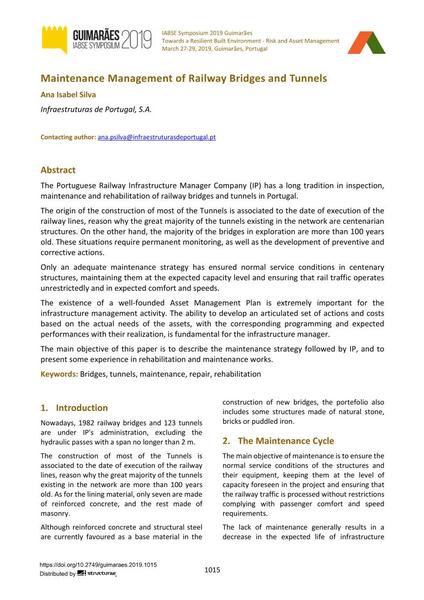Maintenance Management of Railway Bridges and Tunnels

|
|
|||||||||||
Détails bibliographiques
| Auteur(s): |
Ana Isabel Silva
(Infraestruturas de Portugal, S.A.)
|
||||
|---|---|---|---|---|---|
| Médium: | papier de conférence | ||||
| Langue(s): | anglais | ||||
| Conférence: | IABSE Symposium: Towards a Resilient Built Environment Risk and Asset Management, Guimarães, Portugal, 27-29 March 2019 | ||||
| Publié dans: | IABSE Symposium Guimarães 2019 | ||||
|
|||||
| Page(s): | 1015-1019 | ||||
| Nombre total de pages (du PDF): | 5 | ||||
| DOI: | 10.2749/guimaraes.2019.1015 | ||||
| Abstrait: |
The Portuguese Railway Infrastructure Manager Company (IP) has a long tradition in inspection, maintenance and rehabilitation of railway bridges and tunnels in Portugal. The origin of the construction of most of the Tunnels is associated to the date of execution of the railway lines, reason why the great majority of the tunnels existing in the network are centenarian structures. On the other hand, the majority of the bridges in exploration are more than 100 years old. These situations require permanent monitoring, as well as the development of preventive and corrective actions. Only an adequate maintenance strategy has ensured normal service conditions in centenary structures, maintaining them at the expected capacity level and ensuring that rail traffic operates unrestrictedly and in expected comfort and speeds. The existence of a well-founded Asset Management Plan is extremely important for the infrastructure management activity. The ability to develop an articulated set of actions and costs based on the actual needs of the assets, with the corresponding programming and expected performances with their realization, is fundamental for the infrastructure manager. The main objective of this paper is to describe the maintenance strategy followed by IP, and to present some experience in rehabilitation and maintenance works. |
||||
| Mots-clé: |
ponts tunnel
|
||||
